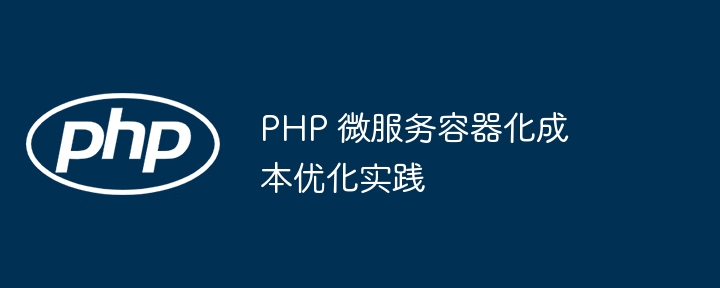Home >Backend Development >PHP Tutorial >PHP microservice containerization cost optimization practice
PHP microservice containerization cost optimization practice
- 王林Original
- 2024-05-08 15:36:011308browse
PHP microservice operating costs can be significantly reduced by optimizing containerization practices. Best practices include: Selecting thin container images Optimizing container startup time Enable log rotation Turn off unnecessary services Adjust resource limits Practical cases show that combining Alpine Linux base images and multi-stage builds can optimize image size, and disabling Composer dependency automatic loading can reduce Start Time. Following these best practices can effectively reduce costs and improve the price/performance of PHP microservice containerization.

PHP Microservice Containerization Cost Optimization Practice
Containerization has become a popular way to deploy microservices. However, a challenge that comes with this is cost optimization. By optimizing containerization practices, you can reduce the operating costs of microservices. This article will explore best practices for optimizing containerization costs for PHP microservices and provide practical examples.
Best Practices
1. Choose the right container image
Use multi-stage builds to minimize the size of the final application image. Consider using a stripped-down base image like Alpine Linux instead of Debian or Ubuntu.
2. Optimize container startup time
Use the preload module to preload the code and dependencies required for the container from the hard disk. This can significantly shorten container startup time and thus reduce computing costs.
3. Enable log rotation
Limit the size of container log files to avoid unnecessary storage costs. This can be achieved using tools such as Logrotate.
4. Shut down unnecessary services
Use Supervisord or Docker Entrypoint script to disable unnecessary services when the container starts. This reduces memory and CPU usage, thereby lowering costs.
5. Adjust resource limits
Set reasonable container resource limits, such as CPU and memory, to prevent resource exceeding. This helps avoid exceeding cost limits.
Practical Case
The following is a practical case for optimizing PHP microservice containerization:
# 基于 Alpine Linux 的多阶段 Dockerfile FROM php:8-alpine AS build # 安装 Composer 依赖项 RUN composer install --no-dev # 发布阶段 FROM php:8-alpine AS release # 复制 Composer 依赖项 COPY --from=build /usr/local/bin/composer /usr/local/bin/composer COPY --from=build /vendor /vendor # 启动 PHP-FPM CMD ["php-fpm"]
This Dockerfile uses the Alpine Linux base image and combines multi-stage construction to optimize the image size. Also reduces startup time by disabling automatic loading of Composer dependencies.
Conclusion
By applying these best practices, you can effectively optimize the cost of containerizing PHP microservices. Opting for thin mirroring, optimizing startup times, enabling log rotation, turning off unnecessary services, and adjusting resource limits can significantly reduce operating expenses.
The above is the detailed content of PHP microservice containerization cost optimization practice. For more information, please follow other related articles on the PHP Chinese website!

